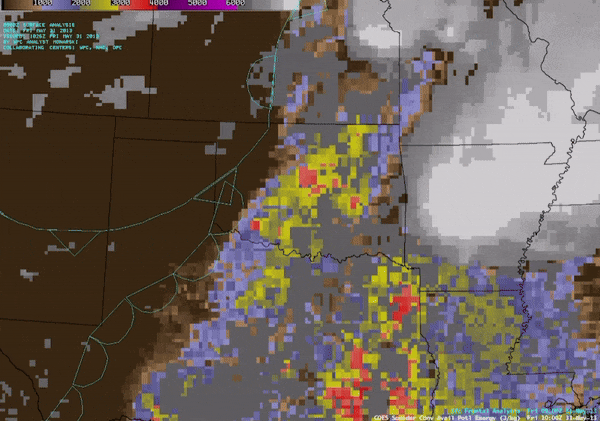On October 28, 2020, Hurricane Zeta made landfall as a category 3 hurricane in Louisiana with winds of up to 115 mph and a pressure of 970 mb. It originally formed in the Caribbean Sea and tracked across the Yucatan Peninsula before rapidly intensifying in the Gulf of Mexico. After making landfall, the storm raced across the southeastern United States, at times moving up to 40 mph. Because of this, tropical storm conditions and winds were brought unusually far inland.

Figure 1. Visible imagery of Hurricane Zeta making landfall. (Source: NOAA)
As Zeta approached landfall, a large storm system was in place over the western United States. A very deep trough was situated in the Southwest, centered over New Mexico and Texas, bringing cold air far south. A strong cold front was attached to this system along with a stationary front extending to the Northeast. As this storm moved east, Zeta was forced to accelerate northeastward as well. As Zeta approached landfall, sea surface temperatures were decreasing and wind shear was increasing, which generally would weaken a tropical cyclone. However, the other system provided favorable upper level dynamics for Zeta and allowed it to intensify until it made landfall.

Figure 2. 500 mb heights and wind speeds. Contours represent height in meters. Lighter blue shades indicate higher wind speeds. Zeta is the area of blue over the Gulf of Mexico. (Source: SPC Mesoscale Analysis Archive)

Figure 3. Infrared satellite loop of Hurricane Zeta nearing landfall. The orange and red areas on the storm indicate the coldest cloud tops and the deepest convection. The red lines indicate unfavorably high wind shear. Despite this, strong upper level dynamics helped Zeta further intensify. (Source: CIMSS Satellite Blog)
Because Zeta was moving so quickly, tropical storm force conditions persisted much farther inland than normal. Winds gusted as high as 60 mph even as the storm approached the Georgia-Alabama border. In Georgia, wind damage in Metro Atlanta led to $1.1 billion in damages, making the storm one of the top five costliest tropical cyclones for the state. As shown in the radar loop below, areas of high rainfall did not dwell on any areas for too long, so flooding was not too large of an issue.

Figure 4. Radar loop of Zeta making landfall. Areas of yellow and orange indicate the highest rainfall rates. The loop covers October 28, 20:55 UTC to October 29, 11:55 UTC. (Source: UCAR Radar Archive)
As seen in the radar loop above, as the storm began to move to the northeast, a band of storms formed over southern Alabama and Georgia. This marks the formation of a frontal feature and the transition of the storm from a tropical cyclone to an extratropical cyclone. Eventually, the storm became caught within the stationary front and fully lost its tropical characteristics. The remnant low pressure and moisture was able to interact with the cold air behind the front and bring an early season snowstorm to parts of New England. The overall snow totals for the area are shown below.

Figure 5. Snow totals over New England. (Source: NWS Boston)



































